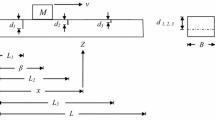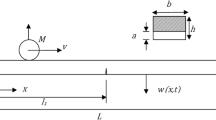Abstract
It is important to identify the presence of damage present in the structures like bridge which undergoes the excitation due to moving vehicles. In such type of problems, modal analysis and dynamic displacement response analysis are not sufficient to portray the crack presence. The presented work emphases on the analysis of acceleration response to investigate the crack presence. A mathematical model is developed by considering the two masses with fixed distance between them traversing on the Euler–Bernoulli beam having a crack. The acceleration response analysis can be effective to present the qualitative explanation of the fault present in the beam. A key features of the acceleration response of beam having a crack includes discontinuity at the crack location which vary with change in distance between the front and rear wheel and a greater response value compare to that for healthy in the last phase of travel from the time front wheel exits the beam. However, the effectiveness of the presentation of the crack through acceleration response depends upon the fixed distance between the front and rear wheel and the bridge length. The discontinuity will be higher for the higher ratio of distance between the front and rear wheel to the bridge length.











Similar content being viewed by others
Abbreviations
- \(c\) :
-
Sectional flexibility
- \(\vartheta\) :
-
Poissons ratio
- E :
-
Young’s modulus
- I :
-
Moment of inertia
- h :
-
Height of the beam
- a :
-
Depth of crack
- \(Y_{1} \left( x \right)\) :
-
Displacement response of first segment
- \(Y_{2} \left( x \right)\) :
-
Displacement response of second segment
- \(\beta\) :
-
Non-dimensional natural frequency
- \(x\) :
-
Variable distance traveled by vehicle from left end
- \(l_{1}\) :
-
Crack located at distance from the left end of beam
- L :
-
Total length of beam
- t :
-
Time
- ν :
-
Velocity of vehicle
- d :
-
Distance between front and rear wheel
- M 1 :
-
Mass on the front wheel (farthest from the left end)
- M 2 :
-
Mass on the rear wheel
- g :
-
Gravitational acceleration
- q(t):
-
Modal response
- m :
-
Mass of the beam
- ρ :
-
Density of the beam
- A :
-
Cross section of beam
- ω n :
-
nth Natural frequency
References
Ariaei A, Ziaei-Rad S, Ghayour M (2009) Vibration analysis of beams with open and breathing cracks subjected to moving masses. J Sound Vib 326:709–724
Bakhtiari-Nejad F, Mirzabeigy A (2013) Vibration analysis of a beam with breathing crack under moving. In: Recent advances in energy, environment and development, Cambridge. ISBN: 978-1-61804-157-9
Chondros TG, Dimarogonas AD, Yao J (1998) A continuous cracked beam vibration theory. J Sound Vib 215(1):17–34
Fernandez-Saez J, Rubio L, Navarro C (1999) Approximate calculation of the fundamental frequency for bending vibrations of cracked beams. J Sound Vib 225(2):345–352
Khorram A, Bakhtiari-Nejad F, Rezaian M (2011) A study on the dynamic response of a singly cracked beam subjected to a moving load. In: 5th international conference on structural health monitoring of intelligent infrastructure (SHMII-5), Cancun
Lee HP, Singapore TY (1994) Ng. Dynamic response of a cracked beam subject subjected to a moving load. Acta Mech 106:221–230
Lin H-P (2007) Vibration analysis of a cracked beam subjected to a traveling vehicle. In: 14th international congress on sound and vibration, Cairns
Lin H-P, Chang S-C (2006) Forced responses of cracked cantilever beams subjected to a concentrated moving load. Int J Mech Sci 48:1456–1463
Mahmoud MA, Zaid MAA (2002) Dynamic response of a beam with a crack subject to a moving mass. J Sound Vib 256(4):591–603
Pala Y, Reis M (2012) Dynamic response of a cracked beam under a moving mass load. J Eng Mech. https://doi.org/10.1061/(ASCE)EM.1943-7889.0000558
Vaidya TS, Chatterjee A (2017) Vibration of road bridges under moving vehicles: a comparative study between single contact point and two contact point models. Trans Can Soc Mech Eng 41(1):2017
Wang C-S, Lee L-T (2012) Modified and simplified sectional flexibility of a cracked beam. J Appl Math 2012:1–16
Yang J, Chen Y, Xiang Y, Jia XL (2008) Free and forced vibration of cracked inhomogeneous beams under an axial force and a moving load. J Sound Vib 312:166–181
Zhong S, Oyadiji SO (2007) Analytical predictions of natural frequencies of cracked simply supported beams with a stationary roving mass. J Sound Vib 311:328–352
Zhong S, Zhong J, Zhang Q, Maia N (2017) Quasi-optical coherence vibration tomography technique for damage detection in beam-like structures based on an auxiliary mass induced frequency shift. Mech Syst Signal Process 93:241–254
Author information
Authors and Affiliations
Corresponding author
Rights and permissions
About this article
Cite this article
Vaidya, T., Chatterjee, A. Crack Estimation of Beam Under the Moving Mass Using the Dynamic Characteristics Based on Two Contact Point Theory. Iran J Sci Technol Trans Mech Eng 43 (Suppl 1), 307–326 (2019). https://doi.org/10.1007/s40997-018-0159-8
Received:
Accepted:
Published:
Issue Date:
DOI: https://doi.org/10.1007/s40997-018-0159-8




